The Clevo P870DM2 / Mythlogic Phobos 8716 Laptop Review: DTR With GTX 1080
by Brett Howse on October 27, 2016 2:00 PM ESTSystem Performance
Although there are several processor options in the Clevo P870DM2, Mythlogic has outfitted the review unit with the highest performance model they offer: the Intel Core i7-6700K. For those familiar with Intel’s lineup of processors, they offer several model lines, with the lowest power ones being the Y series, which are 4.5-Watt, and then the 15/28W U series, and then the highest tier of their mobile processors in the H and HQ, with the latter being the quad-core mobile parts. These top out at 45-Watts, and we see them in almost all gaming laptops. Clevo is marketing this as a desktop replacement, and as such, every processor option is from the Desktop lineup. The majority of the processor options are in the 65-Watt series from Intel S lineup, featuring quad-cores and 6 MB of cache. The processor in the Phobos 8716 review unit is from the K series, with a 91-Watt TDP, 4.0-4.2 GHz, 8 MB of cache, and it is unlocked for overclocking. From a power perspective, the Core i7-6700K has just over twice the thermal headroom of a typical H series processor found in a gaming notebook. Twice the TDP doesn’t mean twice the performance, of course, but there is certainly a lot more potential performance on tap than any H series could offer.
To see how much performance is available, the Clevo P870DM2 was run through our standard lineup of tests, and then compared against several other systems. Of particular interest will be comparisons against the last Desktop Replacement notebook that we tested in the Clevo P750ZM, which was outfitted with the Devil’s Canyon Core i7-4790K, and that CPU actually has a slight frequency advantage over the i7-6700K, with the former topping out at 4.4 GHz and the latter at 4.2 GHz, but with the advantage of the Skylake architecture versus the Haswell architecture in Devil’s Canyon. As always, check out our notebook bench if you’d like to compare this laptop to any other we have tested.
PCMark

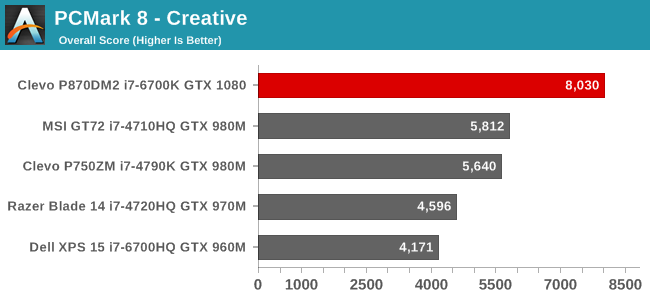

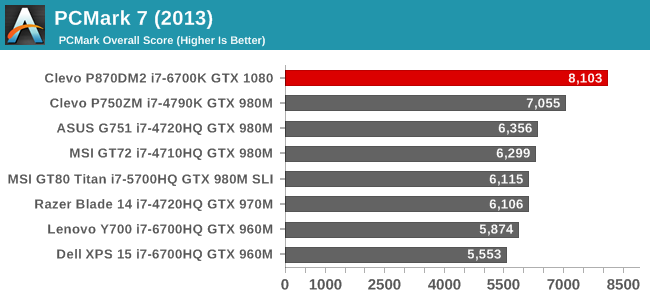
Our first tests are from Futuremark’s PCMark benchmark. This test runs through several real-world applications, and is a complete system test, from the storage to the CPU to the GPU. The Phobos 8716 sets a new bar here for performance in a notebook. That’s not surprising since it has the fastest CPU, the fastest GPU, and the fastest SSD in the Samsung 950 Pro.
Cinebench
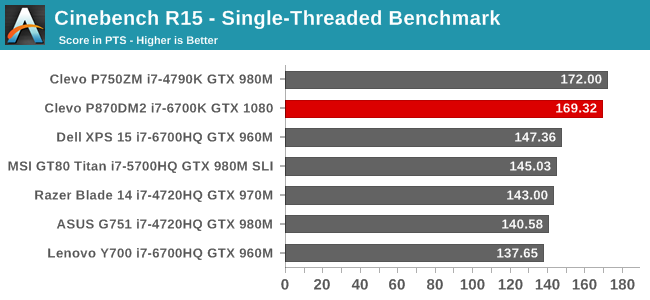
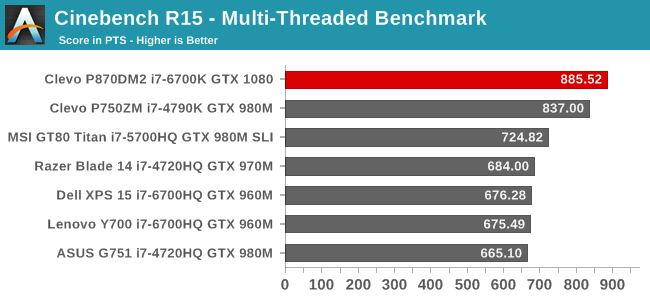
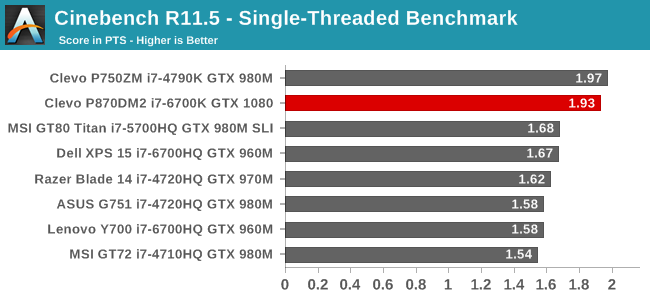
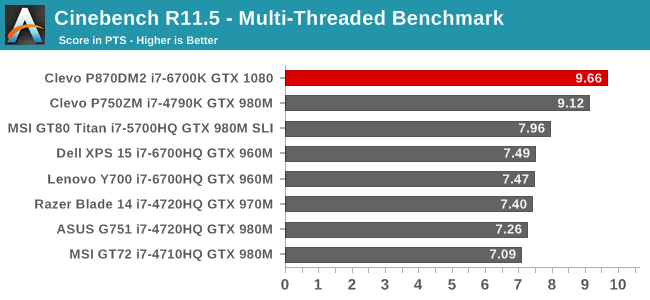
This test tends to be focused on pure CPU performance, and more cores with higher frequencies tend to dominate on this test. We can see that as well with the Devil’s Canyon in the P750ZM slightly edging the Skylake i7-6700K, thanks to a higher turbo frequency available, but only on the single-core tests. On the multi-core tests, the Skylake pulls ahead with its more advanced multi-core turbo, and benefits like Speed Shift.
x264
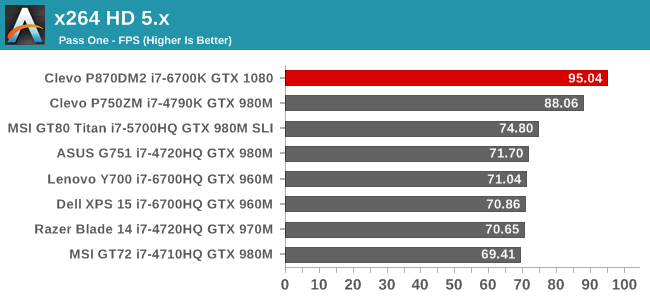
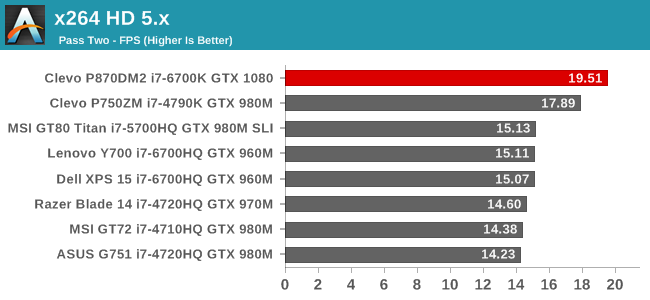
The better multi-core performance of Skylake once again pulls ahead easily here, with performance significantly better than the Haswell Devil’s Canyon.
Web Tests
Finally, web performance is always a priority, although it can be heavily influenced by the browser and platform. It is still something that everyone does every day. When Windows 10 launched, we switched to Edge for our tests, from Chrome on previous versions of Windows. Each browser is marked in the results.

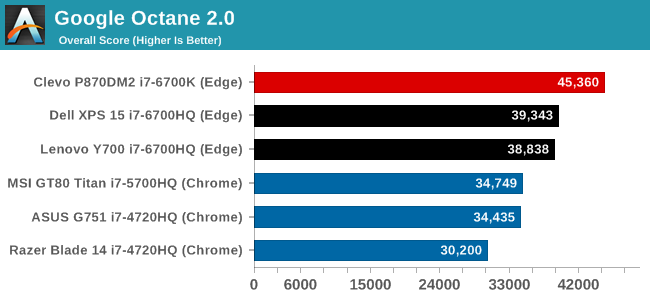


It should come as no surprise after the previous benchmarks that the Clevo P870DM2 / Mythlogic Phobos 8716 easily trounces all previous computers on our web benchmarks as well. Packing a desktop CPU into a notebook has some drawbacks in terms of heat dissipation, but at the end of the day the performance is a good jump ahead of any of the H series processors.
Storage Performance
As with any of these boutique computers, there is quite a bit of customization available on all of the components, and the storage is no exception. For the review unit, Mythologic supplied the Samsung 950 Pro NVMe SSD, and if you saw the review on that drive, you’d be aware that it is one of the fastest consumer SSDs available today, and in fact was only recently pipped with the introduction of the 960 Pro.
With the 256 GB model which is in the review unit, there are not the maximum amount of NAND dies to give the maximum performance, but regardless the results are still very, very good. Read rates approaching 2000 MB/s is likely going to be enough for almost anyone. Mythlogic will outfit the Phobos 8716 in multiple ways, and there are actually two M.2 slots if you need more SSD storage, and also two 2.5-inch SATA slots as well if you need a bit more bulk storage for game downloads.


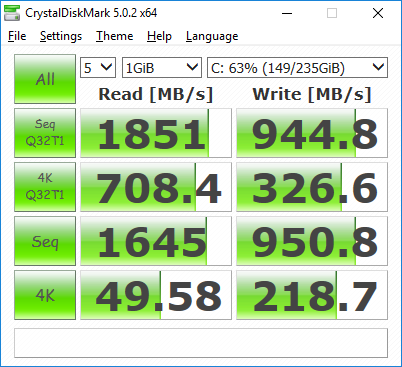








61 Comments
View All Comments
Morawka - Thursday, October 27, 2016 - link
i dont think nvidia is done with pascal mobile parts. I'm sure they will release some midrange stuff here soon.Meaker10 - Friday, October 28, 2016 - link
The vapor chamber cooler on the SLI 1080 config can keep both cards at 1910mhz core clocks during gaming with both cards loaded with the right mounting :)The_Assimilator - Friday, October 28, 2016 - link
Given that Pascal is probably the last gasp of the Maxwell architecture, I think it was a simple matter of nVIDIA wanting to push it as far as it could go. (That, and wanting to crush AMD Polaris.) So slightly higher TDP was probably not a concern of theirs, especially given how much more performance you're getting for that power.As for your desire for potentially slower cards that draw even less power, I'm actually with you on that one. I'm tired of seeing "low-end" cards that require dual-slot cooling and additional power connectors. Bloody hell, back in the day, the 8800 GT was near the top of the hill in terms of performance and it was a single-slotter with 1 PCIe power connector.
BillyONeal - Thursday, October 27, 2016 - link
I'm happy they stopped with the mobile GPU mess. I was sick of looking at laptops and having no idea how they'd perform because the nomenclature of the desktop and mobile parts were different, and nobody did reviews or had good benchmarks of the mobile parts.Sure, due to thermal constraints the mobile implementations are going to perform a little bit worse than desktop equivalents in some circumstances, but not ~50% worse as was common just a few years ago.
Spunjji - Friday, October 28, 2016 - link
We have a new problem, though - actual performance is extremely dependent on cooling implementation due to the huge delta in boost clocks these things can produce.It's great from the perspective of getting the most possible out of your own device, but from a view of trying to buy a notebook it's a bit nightmarish.
BillyONeal - Friday, October 28, 2016 - link
Sure, but that was also true with "m" branded GPUs. Crappy cooling will still tank perf.versesuvius - Thursday, October 27, 2016 - link
DTR or overspeced (overspect ?) AIO?Michael Bay - Thursday, October 27, 2016 - link
Top cover. Just why.anactoraaron - Thursday, October 27, 2016 - link
"But Mythlogic also adds their own tools to do a couple of things. Mythlogic has a control center..."Correct me if I'm wrong but that looks like the standard Clevo control center. I have that on my 2 year old Clevo W370ss. I don't have the other software, but from the ui design I would assume that it is Clevo software also. Nothing looks to be exclusive to Mythlogic to me.
anactoraaron - Thursday, October 27, 2016 - link
Also after seeing the performance relative to the 980M, that new surface aio looks even less worth the money. MS didn't need to go full 1080, but a 1070 or even a 1060 would have been a better choice. Don't get me wrong, but with the surface devices it seems to me like they keep missing the mark, and I keep telling myself 'maybe they'll get the next one right and I'll pick one up.' Only to get let down every year.